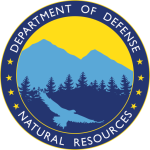


The Recovery and Sustainment Partnership Initiative (RASP) builds on years of collaboration and innovation under the Endangered Species Act (ESA) between the Department of Defense and the Department of the Interior (DOI). The partnership was formalized in 2018 to develop and promote species conservation while promoting increased flexibility for military mission activities. The RASP was established to better address the dynamic relationship between species needs and mission activities and demonstrates how collaborative partnerships can achieve real-world successes for both military readiness and species conservation.
The RASP utilizes the following strategies to achieve its goals:
- Develop innovative regulatory approaches and tools for achieving the intent of the ESA in a manner consistent with both the U.S. Fish and Wildlife Service and military mission needs and objectives;
- Develop collaborative conservation initiatives to enhance species conservation, advance species recovery, and preclude the need to list additional species;
- Recognize and respond to the current and projected impacts of climate change on ecosystems and watersheds, and on the species within those ecosystems and watersheds; and
- Recognize successes in support of conservation goals and targets.
DoD plays a critical role in managing habitats on its installations and ranges across the country that support over 550 threatened and endangered species under the ESA, as well hundreds of additional species at risk for listing. The RASP supports ongoing natural resource management and partnership efforts to address imperiled species, important habitats, invasive species, and other key natural resources, which in turn helps avoid or minimize mission impacts while enhancing species conservation and increasing habitat connectivity.
RASP Memorandum of Understanding (2024)
RASP Memorandum of Understanding (2018)

| DoD-DOI Recovery and Sustainment Partnership (RASP) Initiative Mission Priority and Sensitive Species List 2023 | ||
|---|---|---|
| Species | Scientific Name | USFWS Lead Region |
5 San Clemente Island Species:
|
|
Pacific Southwest (Region 8) |
| Stephens’ kangaroo rat | Dipodomys stephensi | Pacific Southwest (Region 8) |
| Guam orchid | Tuberolabium guamense | Pacific (Region 1) |
| Desert tortoise | Gopherus agassizii | Pacific Southwest (Region 8) |
| Golden-cheeked warbler | Setophaga chrysoparia | Southwest (Region 2) |
| Red-cockaded woodpecker | Picoides borealis | Southeast (Region 4) |
| Okaloosa darter | Etheostoma okaloosae | Southeast (Region 4) |
| Hawaiian stilt | Himantopus mexicanus knudseni | Pacific (Region 1) |
3 snails on the Island of Guam:
|
|
Pacific (Region 1) |
| Inyo California towhee | Pipilo crissalis eremophilus | Pacific Southwest (Region 8) |
| Sonoran pronghorn | Antilocapra americana sonoriensis | Southwest (Region 2) |
| Eastern indigo snake | Drymarchon couperi | Southeast (Region 4) |
| California least tern | Sterna antillarum browni | Pacific Southwest (Region 8) |
| Marbled murrelet | Brachyramphus marmoratus | Pacific (Region 1) |
| Monarch Butterfly | Danaus plexippus | Midwest (Region 3) |
4 Bats:
|
|
Midwest (Region 3); Northeast (Region 5) |
| Taylor’s checkerspot butterfly | Euphydryas editha taylori | Pacific (Region 1) |
| Mazama pocket gopher | Thomomys mazama | Pacific (Region 1) |
| Streaked horned lark | Eremophila alpestris strigata | Pacific (Region 1) |
| Least Bell’s vireo | Vireo bellii pusillus | Pacific Southwest (Region 8) |
| Spotted Turtle | Clemmys guttata | Southeast (Region 4) |
| Gopher Tortoise | Gopherus polyphemus | Southeast (Region 4) |
| Eastern Diamond-backed Rattlesnake | Crotalus adamanteus | Southeast (Region 4) |
| Northern Red-bellied Cooter | Pseudemys rubriventris | Northeast (Region 5) |
| Alligator Snapping Turtle | Macrochelys termini | Southeast (Region 4) |
| Gopher Frog | Lithobates capito | Southeast (Region 4) |
| Wood Turtle | Glyptemys insculpta | Northeast (Region 5) |
| Western Pond Turtle | Actinemys marmorata pallida | Pacific Southwest (Region 8) |
| Blanding’s Turtle | Emydoidea blandingii | Midwest (Region 3) |
| Western Spadefoot | Spea hammondii | Pacific (Region 1) |
| Florida Pinesnake | Pituophis melanoleucus mugitus | Southeast (Region 4) |
| Northern Bobwhite | Colinus virginianus | |
| Burrowing Owl | Athene cunicularia | Washington Office (HQ) |
| Cerulean Warbler | Setophaga cerulea | Midwest (Region 3) |
| Rusty Blackbird | Euphagus carolinus | |
| Henslow’s Sparrow | Ammodramus henslowii | Midwest (Region 3) |
| Golden-winged Warbler | Vermivora chrysoptera | Midwest (Region 3) |
| Bachman’s Sparrow | Peucaea aestivalis | Southeast (Region 4) |
| Least Tern (Atlantic Coast Population) | Sternula antillarum | Washington Office (HQ) |
| Mountain Plover | Charadrius montanus | Mountain Prairie (Region 6) |
| Tricolored Blackbird | Agelaius tricolor | Pacific (Region 1) |
| Southeastern American Kestrel | Falco sparverius Paulus | Southeast (Region 4) |
| Pinyon Jay | Gymnorhinus cyanocephalus | Mountain Prairie (Region 6) |
| Greater Sage-Grouse | Centrocercus urophasianus | Mountain Prairie (Region 6); Pacific (Region 1); Pacific Southeast (Region 8) |
| Bendire’s Thrasher | Toxostoma bendirei | Mountain Prairie (Region 6) |
| Greater Prairie-Chicken | Tympanuchus cupido | |

